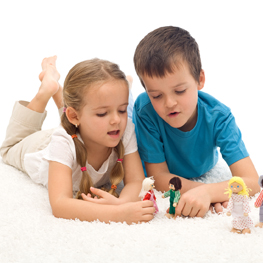
Creative play is the way young children learn. From babyhood on, children use their physical bodies, their imaginations and their relationships with others as they play out stories and situations to make sense of the world around them. Pretending is the way they practice social skills, learn to express their truest feelings and fears; it’s how they manage emotions and solve problems. For today’s busy families, time for unstructured creative play is in short supply. There are jobs and school and sports and community obligations. Our schedules are full. Creative play requires both open spaces of time and an environment conducive to pretending, creating and, yes, to making messes.
Puppets have always been a catalyst for creative dramatic play. Homemade puppets are even more fun because children can create their own characters. Once a puppet is made, it just begs to speak, and before you know it, you have a play! Preschool children often enjoy finger puppets and may learn to sing nursery rhymes or learn to count using them. As children grow older, the puppets can be more elaborate and include button features or glued-on hair. The sky is the limit in originality when creating puppets - they are just plain fun for kids!
Materials for puppets can be found around the house or in craft stores (see the materials list at the end of the article). There are spoon puppets, using the bowl of the spoon for the head; paper bag puppets, where the fold becomes the mouth; paper roll puppets, in which a slit becomes a movable mouth; and the list goes on. There are sock puppets, paper plate puppets, Popsicle stick and felt puppets. Adults can model the creation of several of these characters, but please allow children to come up with their own creations. Who cares if the dog has five legs or the dragon is orange? It’s the creative process that is important. Even more importantly, it’s the dramatic play that follows the creation that is the real payoff.
Once the characters are finished, it’s time to put them to work. Children can use them to act out well-known stories such as fairytales or use them to recite poems. Make generic boy, girl, mom and dad puppets to act out family and friend stories. Create cartoon characters or animal characters from books to retell favorites. Create imaginary creatures with powers to fly or live a thousand years - whatever the children invent.
Now it’s time to perform. All children love to perform in front of a friendly, family audience. It’s one of the few times they have the floor and they love it. They may have written a program for their play or maybe they’ve created tickets for the event. They may have added music and made props for their performance. The stage could be a table turned on its side or the back of the couch. A large cardboard box with a screen cut out works well too. It needn’t be fancy - the magic of pretend will prevail. Remember to be an enthusiastic and supportive audience member.
Don’t be alarmed if your child’s plays are filled with mock arguments and fights or if they play out fears of danger and mayhem. The drama takes them into a world where it’s okay to be angry or afraid and it’s safe to tell another character that they hate eating their peas. Creative dramatics is a healthy outlet for your child’s emotions. Sometimes the content of their play will give you clues to inner turmoil and provide an opportunity to talk about the things that are hard to say otherwise.
Creative play is valuable to your child’s social and emotional growth. It’s key to their artistic development. It’s an important part of a healthy self-concept. So set the stage for your children to have some fun. Create homemade puppets.
Puppet creation central: your craft corner
Websites with simple puppet-making information
For a huge variety of simple homemade puppets, visit funfamilycrafts.com/tag/puppets
For paper plate animal puppet designs, visit dltk-kids.com/animals/paper_plates.html
Jan Pierce, M.Ed., is a retired teacher and a freelance writer. She travels to India where she and her husband support orphanages and schools.
Calgary’s Child Magazine © 2024 Calgary’s Child